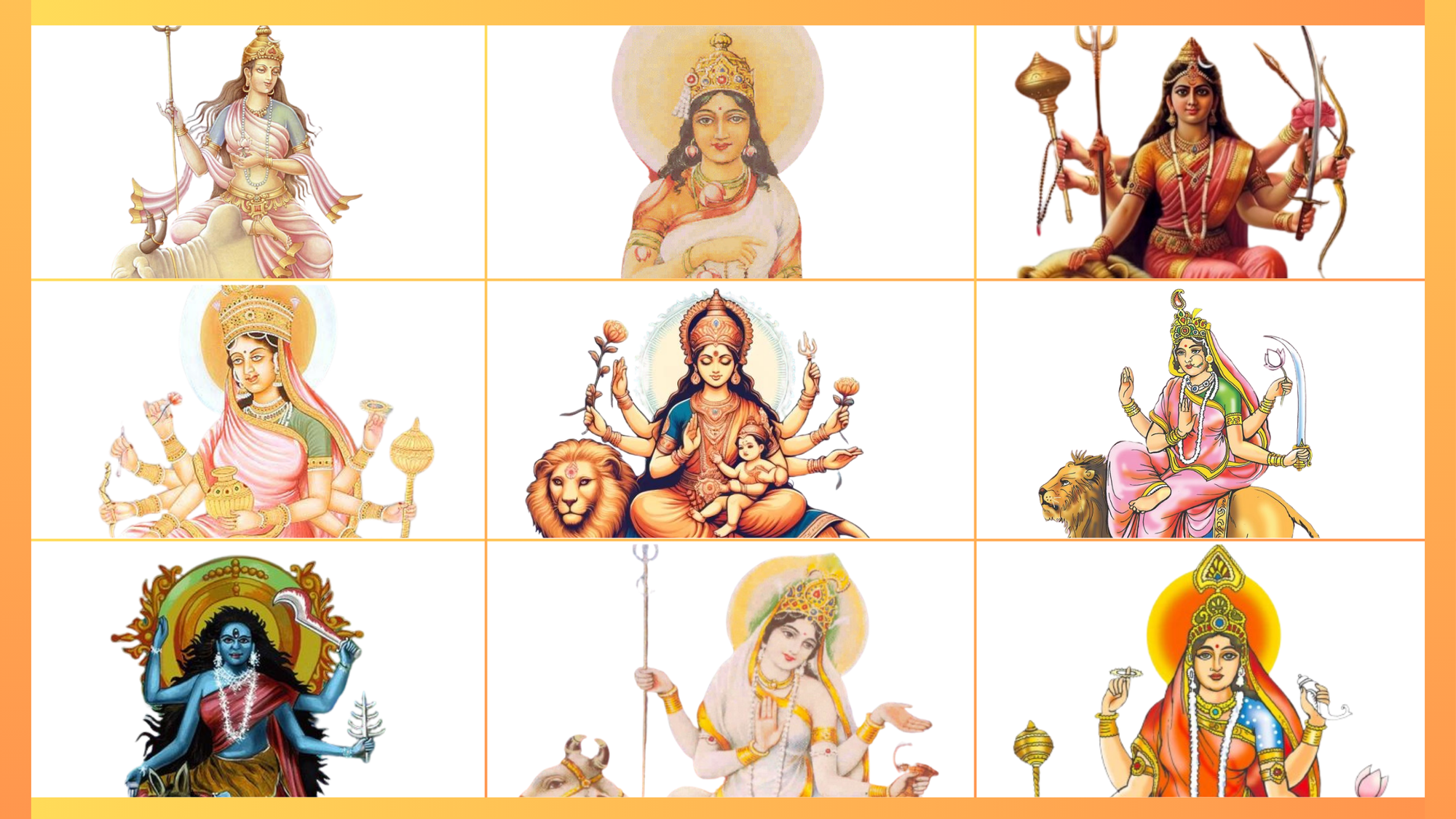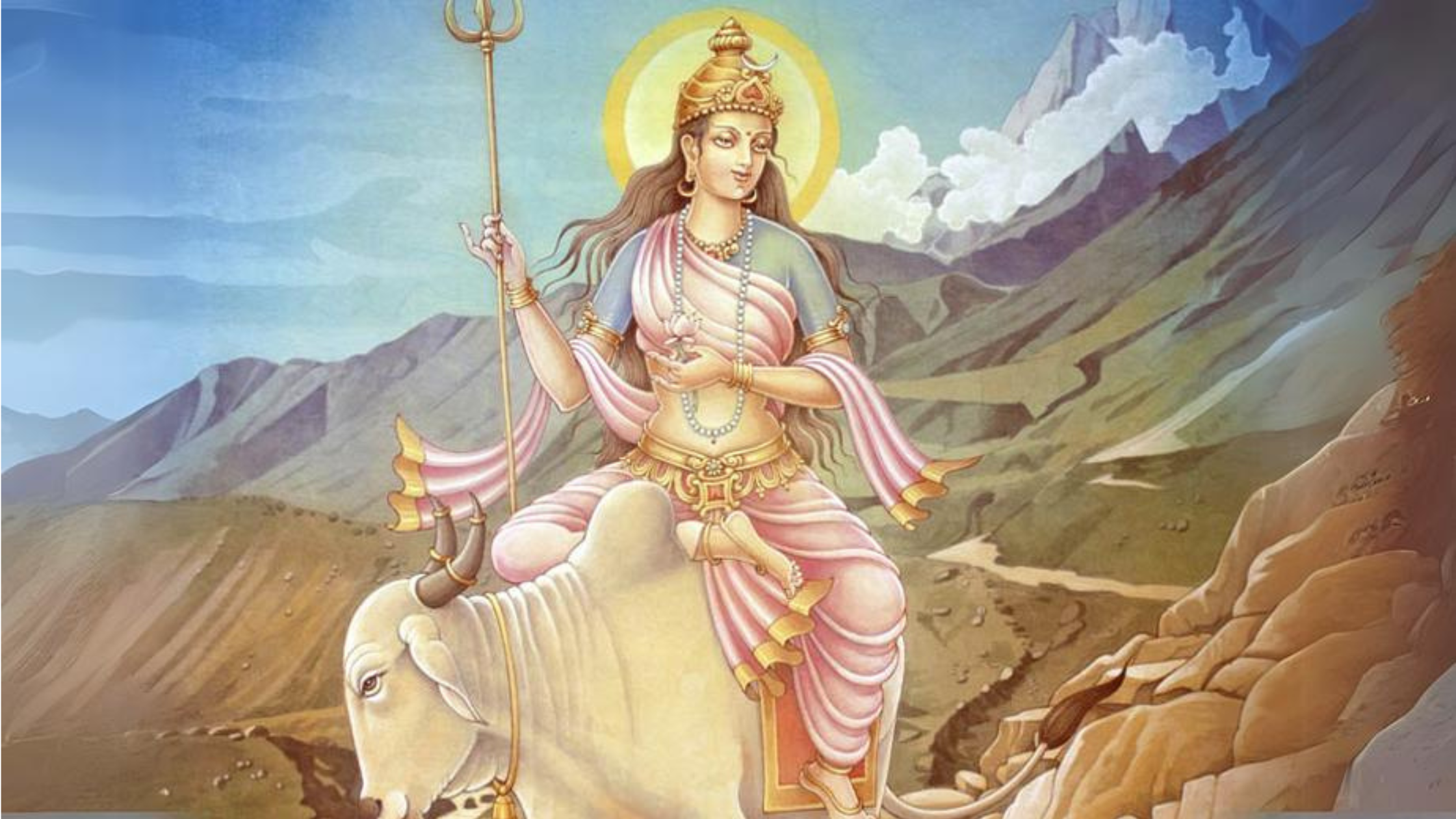Nine Forms of Goddess Durga Worshipped During Navratri

Navratri, a festival celebrated with immense devotion across India and the world, honors the nine divine forms of Goddess Durga. Each day of this sacred festival is dedicated to one of the nine manifestations of the Goddess, each symbolizing a unique virtue and offering her devotees blessings for health, prosperity, protection, and wisdom. From invoking inner strength to fostering spiritual growth, Navratri allows devotees to embark on a journey of transformation. Let's delve into the nine revered forms of Goddess Durga worshipped during Navratri, exploring their significance and the inspiration they offer to the spiritual seeker.
Day 1: Maa Shailaputri - The Symbol of Strength and Devotion
The first day of Navratri is dedicated to Maa Shailaputri, whose name translates to "daughter of the mountain" (Shaila meaning mountain and Putri meaning daughter). Shailaputri is depicted riding a bull and holding a trident in her right hand and a lotus in her left. She represents the embodiment of strength, determination, and devotion.
In her previous incarnation as Sati, she endured great suffering before being reborn as Parvati, the daughter of the mighty Himalayas. Through Shailaputri’s story, devotees are reminded of the importance of perseverance and the strength needed to overcome life’s obstacles. Worshipping Maa Shailaputri on the first day marks the beginning of the spiritual journey, seeking her blessings for devotion and determination.

Day 2: Maa Brahmacharini - The Embodiment of Devotion and Penance
The second form of Goddess Durga is Maa Brahmacharini, symbolizing penance, sacrifice, and unwavering devotion. As an ascetic goddess, Brahmacharini is often depicted walking barefoot, holding a rosary in one hand and a Kamandalu (water pot) in the other. She radiates calm and peace, teaching her devotees about the power of self-discipline and commitment.
In this form, Brahmacharini performed intense austerities to win the love of Lord Shiv. Through her example, we are encouraged to remain focused on our goals, endure hardships with patience, and cultivate inner strength. Worshipping Brahmacharini invokes blessings of wisdom, knowledge, and steadfastness on the spiritual path.
Day 3: Maa Chandraghanta - The Warrior Goddess of Serenity and Bravery
On the third day of Navratri, devotees honor Maa Chandraghanta, the warrior form of Durga. This form depicts her with a crescent moon on her forehead, riding a lion and ready for battle. Her name is derived from "Chandra" meaning moon and "Ghanta" meaning bell, signifying her ability to rid her devotees of fear through her divine power.
Although fierce toward evil forces, Chandraghanta radiates serenity and compassion toward her devotees. Her roaring bell is believed to protect her worshippers from negative energies. By invoking her on the third day, devotees seek strength, courage, and a fearless mind, while remaining grounded in peace and humility.
Day 4: Maa Kushmanda - The Creator of the Universe
Maa Kushmanda, the goddess who is believed to have created the universe with her divine smile, is worshipped on the fourth day of Navratri. Her name is a combination of three words: "Ku" meaning little, "Usma" meaning warmth or energy, and "Anda" meaning cosmic egg. It is said that Maa Kushmanda brought light to the universe when there was only darkness.
Kushmanda is depicted with eight arms holding various divine objects, symbolizing the creation of the cosmos. She is believed to reside in the core of the Sun, radiating light and energy throughout the universe. Devotees seek her blessings for health, vitality, and prosperity, invoking her divine energy to dispel darkness from their lives.
Day 5: Maa Skandamata - The Nurturing Mother
Maa Skandamata is revered as the mother of Lord Skanda (also known as Kartikeya), the warrior god who led the divine armies against demons. Skandamata is depicted holding her son on her lap, symbolizing her nurturing and protective nature. This form of Durga reminds devotees of the power of the divine mother and unconditional love for the souls.
Worshipping Skandamata on the fifth day of Navratri brings blessings of wisdom and prosperity. Her devotees are encouraged to seek her guidance in times of need, just as a mother would provide protection and support to her children.
Day 6: Maa Katyayani - The Fierce Protector
Maa Katyayani, the warrior form of Durga, is worshipped on the sixth day of Navratri. Born out of the collective power of the gods to defeat the buffalo demon Mahishasur, Katyayani represents the fierce and protective aspect of the Divine Mother. She is depicted with four hands, riding a lion, and wielding a sword and lotus. Click here to read more about Goddess Durga's battle with Mahishasur.
Katyayani is a symbol of righteous anger and the destruction of evil. Her devotees invoke her blessings to remove obstacles and overcome challenges. Young unmarried women also pray to Katyayani for a harmonious and blessed marriage. The Gopis of Braj observed a month long fast and worshipped Goddess Katyayani to obtain Shree Krishna as their husband.
Day 7: Maa Kalaratri - The Destroyer of Darkness
The seventh day of Navratri is dedicated to Maa Kalaratri, the fiercest form of Durga. With a dark complexion, unkempt hair, and a necklace that glows like lightning, Kalaratri is the embodiment of destruction and protection from evil forces. She rides a donkey, holds a scimitar, and breathes fire, terrifying demons and darkness.
Despite her fearsome appearance, Kalaratri is also known as "Subhankari" (the auspicious one) because her blessings bring good fortune to her devotees. Worshipping Kalaratri removes ignorance, darkness, and fear from the lives of her devotees, allowing them to attain spiritual growth.
Day 8: Maa Mahagauri - The Symbol of Purity and Peace
On the eighth day of Navratri, devotees worship Maa Mahagauri, who represents purity, calmness, and serenity. Her name, Mahagauri, means "extremely fair," and she is depicted wearing white garments and riding a bull. She holds a trident in one hand and a damaru (drum) in the other, radiating peace and benevolence.
Maa Mahagauri’s story of undergoing severe penance and being purified by Lord Shiv teaches us that through dedication and devotion, we can overcome obstacles and emerge transformed. Devotees worship Mahagauri to cleanse their hearts and minds, seeking her blessings for purity, inner peace, and prosperity.
Day 9: Maa Siddhidatri - The Giver of Siddhis and Perfection
The final day of Navratri is dedicated to Maa Siddhidatri, the goddess who bestows siddhis (spiritual powers) and fulfills all desires. Seated on a lotus and holding a lotus, mace, discus, and conch in her four arms, Siddhidatri is the ultimate manifestation of divine energy. According to mythology, even Lord Shiv worshipped Siddhidatri to gain his powers.
By worshipping Maa Siddhidatri on the ninth day, devotees seek her blessings for spiritual enlightenment and perfection. She represents the fulfillment of all aspirations and the attainment of both worldly and spiritual success.
In conclusion, Navratri is not only a time to celebrate the divine feminine energy but also a spiritual journey that allows devotees to reflect on their inner strengths, conquer their fears, and invoke the blessings of the Divine Mother. Each form of Goddess Durga offers a unique lesson and a path toward self-realization, encouraging us to embrace qualities like courage, devotion, and wisdom.
As you honor the nine forms of Durga during Navratri, may you experience transformation and spiritual growth. Join the vibrant and spiritually uplifting celebrations at the Radha Krishna Temple of Dallas, where the divine energy of Durga will be invoked through prayers, music, and dance. Embrace the grace and blessings of the Divine Mother and step into a life filled with joy, strength, and wisdom.